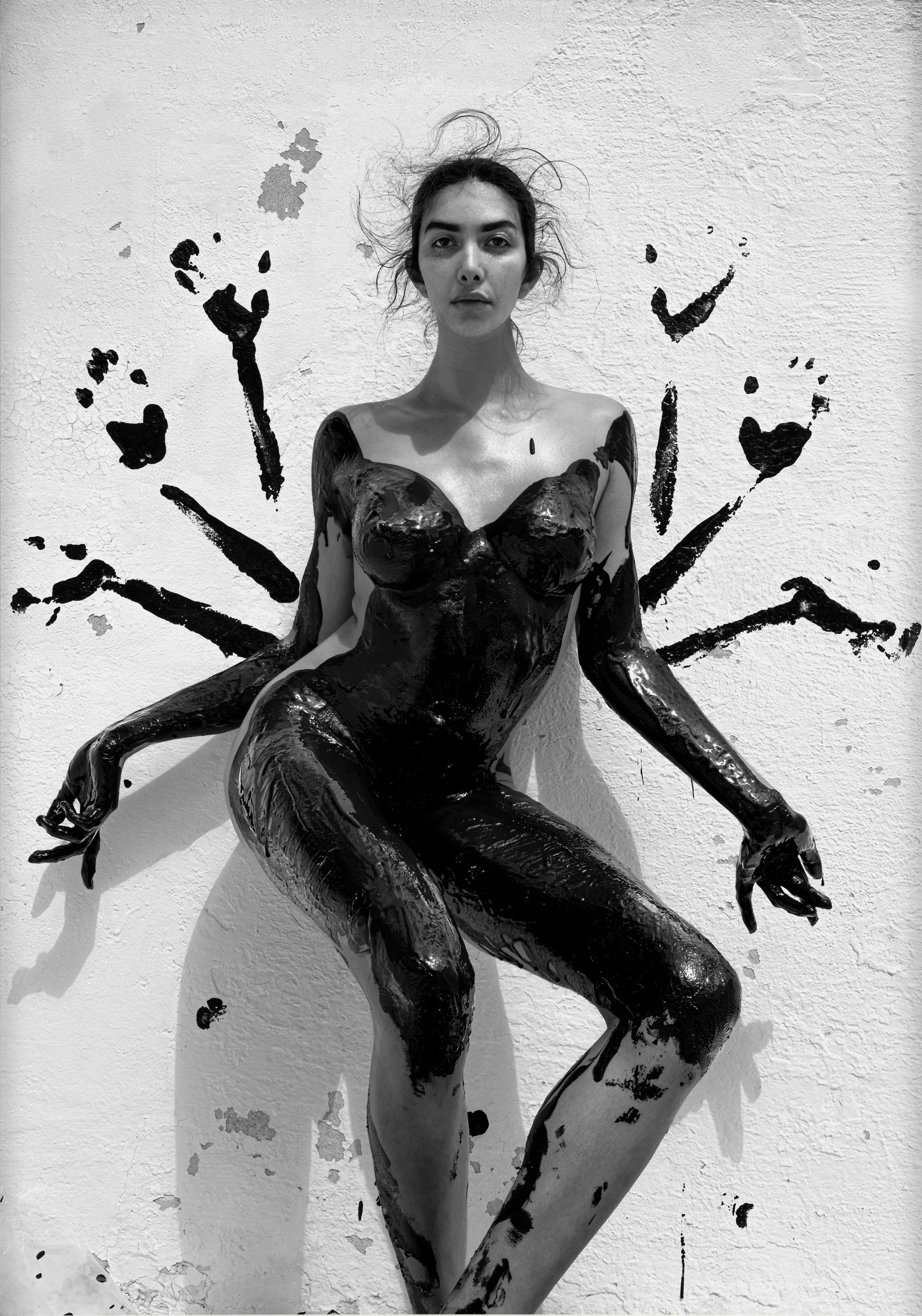Simple wire, garbage bags, and zipties summon goddesses and mythological women in ANTI-ICON: APOKALYPSIS
In a sanctuary of arresting self-portraits at The Polygon Gallery, photography artist Martine Gutierrez plays with identity as she transforms into figures like Mary, Cleopatra, and Lady Godiva
ANTI-ICON: APOKALYPSIS installation view at the Polygon Gallery.
Martine Gutierrez, Ardhanarishvara from ANTI-ICON: APOKALYPSIS. 2021. Tia Collection, Santa Fe, New Mexico, USA.
Anti-Icon: Apokalypsis runs at the Polygon Gallery to September 29
THE LAST TIME Vancouverites saw Martine Gutierrez in her photographic self-portraits at the Polygon Gallery, the artist was decked out in ornate Mayan textiles, cascading jewellery, elaborate headdresses, and long faux nails—all set against vivid pink or turquoise backgrounds. The images came from the trans Latinx-American artist’s Indigenous Woman series, featured in 2021’s colourful, gender-fluid group show Interior Infinite.
The Polygon Gallery’s new exhibit ANTI-ICON: APOKALYPSIS shows a very different side of the Brooklyn-based artist—albeit with the same fashion gloss and questioning of feminine identity. In this show, curated by the Polygon’s Elliott Ramsey, Gutierrez’s 17 large-scale self-portrait photographs are laid out in a black-walled, cathedral-like space with gothic arches. In each, she portrays an iconic woman from mythology, history, or religion—but artfully transforms herself with the most spare and everyday of materials in dramatically lit photographs that are often devoid of colour. Gutierrez conjures Cleopatra with a garbage-bag headdress; an old-testament Judith with a hardware-store-wire sword; a Virgin of Guadalupe with zipties; and a Gabriel with corrugated-cardboard wings. Elsewhere, a Lady Godiva sports tinsel hair and is seated on a sawhorse, and the goddess Ardhanarishvara’s multiple “arms” take the form of black paint playfully sketched against a cement wall.
As Ramsey points out in a gallery tour, Gutierrez employs as few props as possible in ANTI-ICON, “using just provisional materials that happened to be around.” That the tall, striking artist can create such stunning, complex statements out of simple materials (spoiler alert: they were shot in an empty swimming pool at her mother’s place) is a testament to her talent. Often she shapeshifts so dramatically that she’s unrecognizable from one image to the next. Within these portraits she rolls in references to centuries of visual iconography, from Renaissance paintings to Kardashian Instagram posts; Vogue spreads to billboards to old Hollywood epics. Ramsey notes how syncretic the work is, with nods to Hindu, Tibetan, Latin American, and other cultures.
The arresting images first gained a following when they were featured in a 2021 Public Art Fund-sponsored bus-shelter project in New York, Chicago, and Boston. In that setting, they toyed with the iconography of advertisement. (Because most are nudes, Gutierrez reshot her original photographs with veils draped to cover private parts for these public spaces.) At the Polygon’s ANTI-ICON, the first exhibit to show so many of her works in one place, the sanctuary-like setting plays with ideas of reverence and worship. As Ramsey puts it: “taking the divine feminine and putting it under a microscope.”
Martine Gutierrez, Maria from ANTI-ICON: APOKALYPSIS. 2021. Tia Collection, Santa Fe, New Mexico, USA.
“This is nudity, and it’s also trans nudity, and when we think about the very old genre of the nude, which is as old as art history itself, we see very little representation, if not none at all, of trans bodies,” the Polygon curator adds. “It took incredible courage on Martine’s part and we are immensely proud of what we’re getting here at the Polygon—it’s an honour to show it here.”
Perhaps the best way to tackle this exhibit is to wander your way through, guessing who is captured in each portrait—then checking a map booklet to see if you’re right. “Every single one is a figure that lives in the public imagination in some way,” Ramsey says.
What will undoubtedly strike you most—more than the nudity—is the unnerving eye contact in each photograph. Gutierrez seems to be reminding us of the strength and humanity of these women.
Almost every subject is, as Ramsey says, “an iconic woman that is also very aware of the person staring at them and is staring back”. One of the most haunting gazes belongs to Magdalene, with her eerie black halo and ghostly-white-gauze veil. Judith, who beheaded Holofernes in the Bible, snarls fiercely at us as she raises her wire sword over her head. A frazzle-haired, powder-faced Queen Elizabeth I seems to look at us insolently. A seductively posed Godiva makes defiant eye contact. And try to discern what Maria (the Bible’s Mary), veiled in a sheet of liquidy lamé, is trying to get across to us as she fixes us in her intense gaze.
They all seem to be challenging us to reassess them—to question who we choose as icons, what we really know about them, and how we depict them. Who do we worship today, and why? And also: what is femininity, and how can we reimagine it? ![]()
Martine Gutierrez, Cleopatra from ANTI-ICON: APOKALYPSIS. 2021. Courtesy the artist; RYAN LEE, New York; Fraenkel Gallery, San Francisco; and Josh Lilley, London.
















